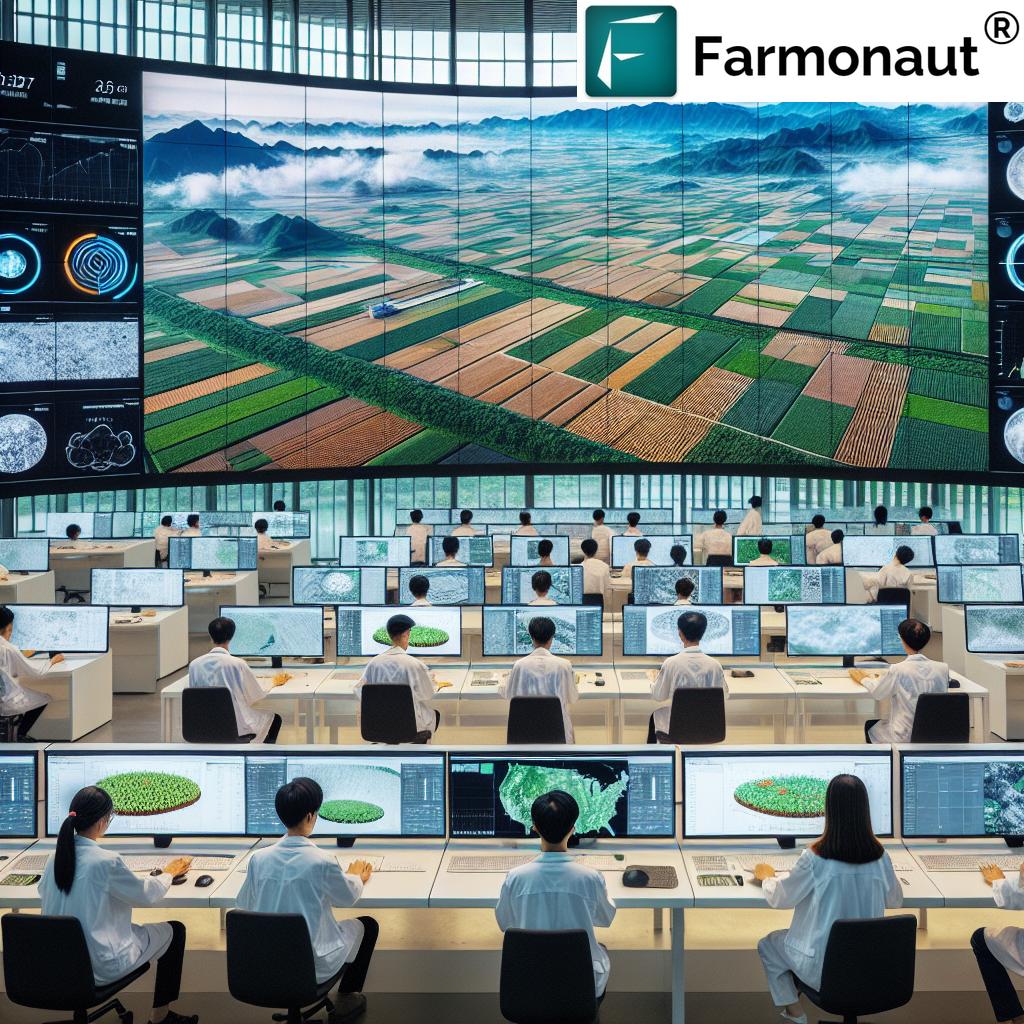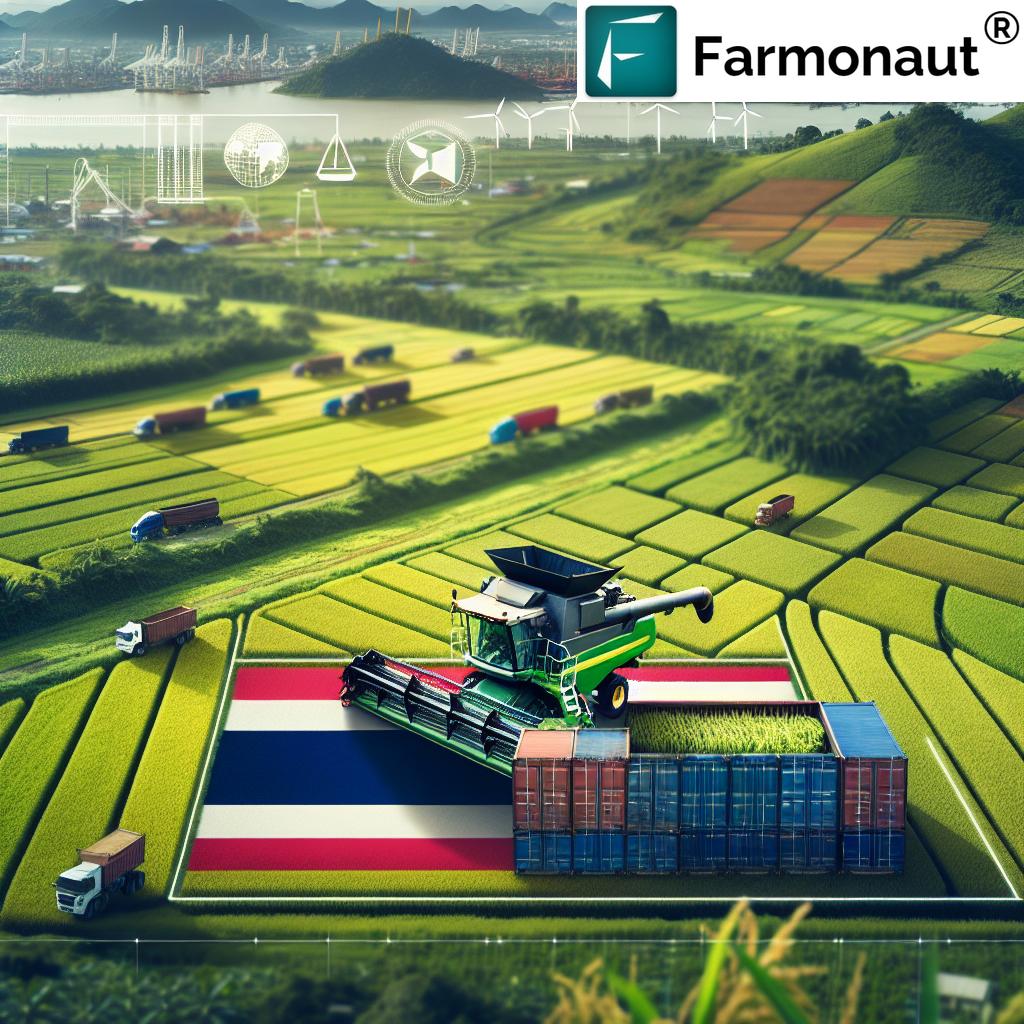- Introduction: The Rise of Japan Farming Technology
- Trivia: Smart Agriculture Adoption in Japan
- Japan Farming Technology: Historical Challenges and the Drive for Innovation
- Precision Farming: Robotics and AI Revolution
- [Video] How AI Drones Are Saving Farms in 2025
- Autonomous Machines and AI-Equipped Robots
- Aerial Drones: Revolutionizing Crop Health Monitoring
- Trivia: Japanese Agricultural Robotics Market Value
- Smart Greenhouses and Vertical Farms in Urban Japan
- [Video] Smart Farming Future: Precision Tech & AI
- Data-Driven Farming: IoT, Sensors, and Big Data
- Smart Systems: Environmental Monitoring and Resource Management
- Comparison Table: Traditional vs. Smart Agriculture in Japan (2025)
- Sustainability and Environmental Stewardship in Japan Farming Technology
- Enabling Japan’s Smart Agriculture: Farmonaut Satellite Solutions
- Labor Shortages and Human-Robot Synergy
- 2025 and Beyond: Future Outlook for Japan Farming Technology
- FAQ: Japan Farming Technology 2025
- Conclusion: Leading the Future of Smart Agriculture
- Farmonaut Subscription Options
Japan Farming Technology: Smart Agriculture 2025
In the realm of global agriculture, Japan farming technology stands as a beacon of innovation and efficiency. Despite limited arable land and an aging farming population, Japan has leveraged advanced technology to transform its agricultural sector into a highly productive, sustainable field.
As we look toward 2025 and beyond, the evolution of Japanese agriculture technology continues to offer valuable solutions for food security, labor shortages, and environmental sustainability. Join us as we explore the breakthroughs in AI, robotics, smart systems, and sustainable practices that are propelling farming in Japan into a new, technologically empowered era.
“By 2025, over 50% of Japanese farms are expected to adopt AI-driven smart agriculture systems.”
Japan Farming Technology: Historical Challenges and the Drive for Innovation
Japan is a country characterized by a shrinking rural workforce and limited arable land, factors that have historically challenged agricultural productivity. In response, Japan farming technology has evolved with a focus on high-tech innovation and precision agriculture.
- With over two-thirds of its land area mountainous and unsuitable for large-scale traditional farming, Japan has pioneered solutions maximizing yield per hectare.
- The aging population of farmers—with the average age exceeding 67 years—makes automated, intelligent systems even more crucial for continued productivity.
- Rising global concerns for food security, urbanization, and environmental sustainability have further energized investment in transformative technology for Japanese agriculture.
Precision Farming with Robotics & AI: The Heart of Japan Technology in Agriculture
Japan technology in agriculture in 2025 centers on precision farming, where AI and robotics intertwine to revolutionize every stage of farming.
- Intelligent machines and autonomous equipment now perform repetitive, labor-intensive tasks such as sowing, weeding, and harvesting, reducing reliance on manual labor.
- Robotic rice transplanters and AI-equipped harvesters optimize inputs like water, fertilizers, and pesticides, ensuring resource efficiency and environmental care.
- Real-time data from embedded sensors inform all machine operations, tailoring each action to the specific needs of every field and crop.
The result? Enhanced productivity, reduced waste, and a scalable model that meets the demands of both small family farms and expansive commercial enterprises.
Autonomous Machines and AI-Equipped Robots
- Autonomous tractors precisely till, seed, and fertilize with minimal human input, using GPS, advanced AI, and onboard sensors to adapt to soil conditions and field requirements.
- Robotic rice transplanters achieve accurate spacing and depth—each plant is set for optimal growth.
- Robotic harvesters use machine vision and AI to identify fruit ripeness, selectively pick, and sort crops—enhancing yield and minimizing damage.
- Labor-intensive processes like weeding and spraying are now automated, saving valuable time and labor resources.
This combination of robotics, AI, and smart systems exemplifies the potential of Japan farming technology to empower farmers while confronting acute labor shortages and an aging workforce.
Aerial Drones: Revolutionizing Crop Health Monitoring
AI-powered drones are one of the most visible, game-changing aspects of agriculture technology in Japan:
- Equipped with high-resolution cameras and multispectral sensors, drones conduct rapid aerial surveys of fields.
- Drones detect plant stress, pest infestations, water scarcity, and nutrient deficiencies, enabling proactive, precision interventions.
- Data is analyzed in real-time by machine learning algorithms to generate actionable insights—ensuring interventions are timely and tailored to each field.
- Robotic sprayers can then be dispatched for focal applications of fertilizers or pesticides, minimizing chemical use and environmental burden.
This AI-driven approach enables farmers to maximize yields, optimize input costs, and protect environmental health.
“Japan’s agricultural robotics market is projected to reach $2.5 billion by 2025, revolutionizing farm productivity.”
Smart Greenhouses and Vertical Farms in Urban Japan
As urbanization continues, Japan has emerged as a pioneer in controlled environment agriculture:
- Smart greenhouses utilize sensors to continuously monitor humidity, temperature levels, carbon dioxide, and nutrient supply.
- Automated systems adjust climate conditions to maximize plant growth and keep yields steady all year, regardless of external climate or weather volatility.
- LED lighting and hydroponic or aeroponic systems reduce water use and accelerate growth cycles, while also making vertical farming in high-density cities possible.
- Vertical farms in cities like Tokyo and Osaka bring fresh produce closer to consumers, reducing food miles and carbon emissions.
These solutions are crucial to Japanese agriculture technology, transforming urban and suburban landscapes with smart, sustainable food production.
Data-Driven Farming: The Integration of IoT, Sensors, and Big Data
A central pillar of Japan farming technology is the use of IoT (Internet of Things) and data-driven systems in agriculture:
- Fields are embedded with soil sensors monitoring parameters such as moisture, temperature, nutrient levels, and plant health—data is fed directly into cloud-based platforms.
- Farmers access tailored guidance on irrigation, fertilizer application, and pest intervention via mobile apps, leading to timely, data-backed decisions.
- Advanced AI and machine learning analyze massive volumes of data to predict disease outbreaks, optimize resource use, and estimate yields.
- Smart systems orchestrate irrigation and fertilization schedules to conserve water and minimize waste.
This integration of IoT sensors and data analytics delivers significant productivity gains, resource savings, and enhances sustainability for Japan’s agricultural sector.

Try Farmonaut’s all-in-one satellite-driven insights app for real-time crop and land monitoring—optimize your farm’s health, input efficiency, and sustainability in one place!
Smart Systems: Environmental Monitoring and Resource Management in Japan Farming Technology
Environmental stewardship is at the forefront of Japan technology in agriculture:
- Real-time resource monitoring with AI and sensors enables precision use of water, pesticides, and fertilizers, drastically reducing waste and runoff.
- Smart scheduling of irrigation and fertilization based on weather predictions (AI-integrated)—ensures plants receive optimal nourishment and water, whatever the season.
- Data-driven pest management: AI models now predict when and where pests are likely to strike, initiating only targeted treatments, instead of broadcast spraying.
- Farmers receive automated alerts via IoT devices and apps to make adjustments or address urgent issues promptly.
These smart systems help Japan set new standards in modern agriculture—delivering improved yields, reduced input costs, and enhanced environmental sustainability.
Explore tailored weather forecasts, AI-based advisories, and satellite-driven insights for your farm’s resource management with Farmonaut’s Jeevn AI Advisory System—maximizing productivity the smart way!
Comparison Table: Traditional vs. Smart Agriculture in Japan (2025)
| Aspect | Traditional Agriculture (Estimated 2025 Values) |
Smart Agriculture Technology in Japan (Estimated 2025 Values) |
Impact / Benefit |
|---|---|---|---|
| Productivity (Yield/ha) | 5.8 tons/ha (Rice) | 8.5 tons/ha (Rice) with optimized inputs | ~46% higher crop yields, improved food security |
| Labor Requirement (Person-Hours/ha) | 600 person-hours/ha/season | 250 person-hours/ha/season | ~58% less manual labor, addresses workforce shortages |
| Resource Efficiency (Water/Fertilizer Usage) | 30% resource waste due to uniform application | Resource use cut by up to 40% via sensors & precision | Lower costs, environmental protection |
| AI/Robotics Integration (% of farms) | 15% (mostly large commercial farms) | 50-55% (across farm sizes) | Modernization, scalable tech adoption |
| Sustainability Metrics (Carbon Emission Reduction) | Baseline only, limited tracking (0% reduction) | Up to 25% carbon emission reduction | Supports Japan’s climate goals, healthier environment |
Sustainable Practices & Environmental Stewardship in Japanese Agriculture Technology
Sustainability is deeply embedded in agriculture technology in Japan for 2025:
- Precision fertilizer application—guided by AI and sensors—minimizes chemical runoff, protecting rivers and wildlife.
- Organic farming practices, enhanced by real-time soil condition monitoring, restore fertility and soil health.
- Bio-based fertilizers and natural pest control solutions are championed across the country, reducing environmental impact and ensuring safe produce.
- Smart carbon footprinting tools enable tracking and management of agricultural emissions—a critical step toward Japan’s climate commitments.
- Sustainable water management systems, powered by sensors, ensure crops receive only what they need—avoiding excess use and conserving resources for future generations.
Explore Farmonaut’s Carbon Footprinting tool: Monitor and minimize the environmental footprint of your farming operations, supporting compliance and global sustainability goals.
Enabling Japan’s Smart Agriculture: Farmonaut Satellite Solutions
As satellite technology accelerates innovation, Farmonaut stands out for empowering all scales of farming in Japan and worldwide:
- Our satellite-based monitoring leverages multispectral imagery to provide real-time insights into crop health, soil conditions, and resource needs—in the palm of your hand.
- With the Jeevn AI Advisory System, we deliver tailored advisories, weather updates, and predictive analytics powered by AI—letting farmers make smart, timely decisions for every season.
- Blockchain-powered traceability secures supply chains, ensuring product authenticity and boosting market access for Japanese producers aiming for export excellence.
- Our fleet and resource management tools optimize equipment usage, enhance safety, and save operational costs across the sector.
- Continuous environmental impact monitoring (including carbon-footprinting) ensures every farm can meet global sustainability goals and report on progress with confidence.
Overcoming Labor Shortages: Human-Robot Collaboration in Japanese Agriculture Technology
With one of the world’s oldest agricultural populations, farming in Japan is challenged by a shrinking workforce:
- Collaborative robots (cobots) support, rather than replace, humans—handling heavy lifting and repetitive tasks while advanced functions are managed by skilled farmers.
- This synergy increases productivity, ensures delicate processes like pruning or fruit selection are handled with care, and makes farming more attractive to younger generations.
- Robotic exoskeletons further reduce the physical burden of farm labor for senior farmers and enable extended working years.
- Remote machinery control via apps or web platforms allows monitoring and supervision of entire farms from a single location.
These approaches ensure farming in Japan is resilient even as demographic and workforce challenges intensify.
Connect your apps and agribusiness platforms directly to Farmonaut satellite insights via our API—bring real-time field health, crop stress, and weather data to your own tools!
Access detailed API documentation for seamless integration.
Japan Farming Technology 2025 and Beyond: Future Outlook
As 2025 arrives, Japan’s farming technology is not only transforming national food systems but also influencing global best practices:
- AI and robotics will become standard on virtually every commercial and family farm, liberating farmers from repetitive tasks and opening doors to smarter, data-driven management.
- Urban farms and vertical greenhouses will continue to expand, feeding Japan’s dense cities with ultra-fresh produce while keeping environmental impact minimal.
- Sustainable agriculture will be attainable even for smallholders, supported by affordable, cloud-connected tools.
- Japanese agriculture technology will set benchmarks for traceability, transparency, and resource stewardship in global agricultural markets.
Japan’s integrated approach—merging tradition and innovation—serves as a valuable blueprint for sustainable, efficient, and resilient farming worldwide.
FAQ: Japan Farming Technology 2025
-
Q: What are the main technologies transforming farming in Japan by 2025?
A: Key technologies include AI-driven decision-making, autonomous machinery, IoT sensors, smart greenhouses, robotics, vertical farming, satellite imagery, and data analytics.
-
Q: How is Japan addressing labor shortages in agriculture?
A: The integration of robotics, cobots, labor-saving machinery, and remote management platforms helps reduce manual demand and attract a new generation to farming.
-
Q: What is the impact of smart agriculture on resource use and sustainability?
A: Smart systems cut water and fertilizer waste by up to 40%, contribute to up to 25% carbon emission reduction, and protect soil and ecosystem health via precision applications and monitoring.
-
Q: How do farmers access these smart technology platforms?
A: Many platforms such as Farmonaut are accessible via web, Android, and iOS apps, as well as APIs—democratizing advanced technology for farms of all sizes.
-
Q: Is Japanese smart agriculture influencing global farming methods?
A: Yes. Japan’s fusion of data, robotics, and sustainability is influencing agricultural best practices worldwide, especially in resource-constrained and aging-population contexts.
Conclusion: Leading the Future of Smart Agriculture
Japan farming technology in 2025 is more than a collection of advanced machines—it’s an integrated system fusing AI, robotics, smart data, and sustainable practices for a resilient, environmentally responsible, and highly productive agricultural sector.
Japanese agriculture technology is now recognized among the world’s most innovative, addressing challenges like labor shortages, limited arable land, and climate volatility with tailored, impactful solutions. As farming Japan continues to set the pace, its blend of tradition and technology offers a model of sustainability, efficiency, and global leadership—an inspiring roadmap for agricultural futures everywhere.
Farmonaut Subscription Options
Ready to bring next-generation monitoring, advisory, and sustainability solutions to your farm or agri-business? Explore all subscription options below!









